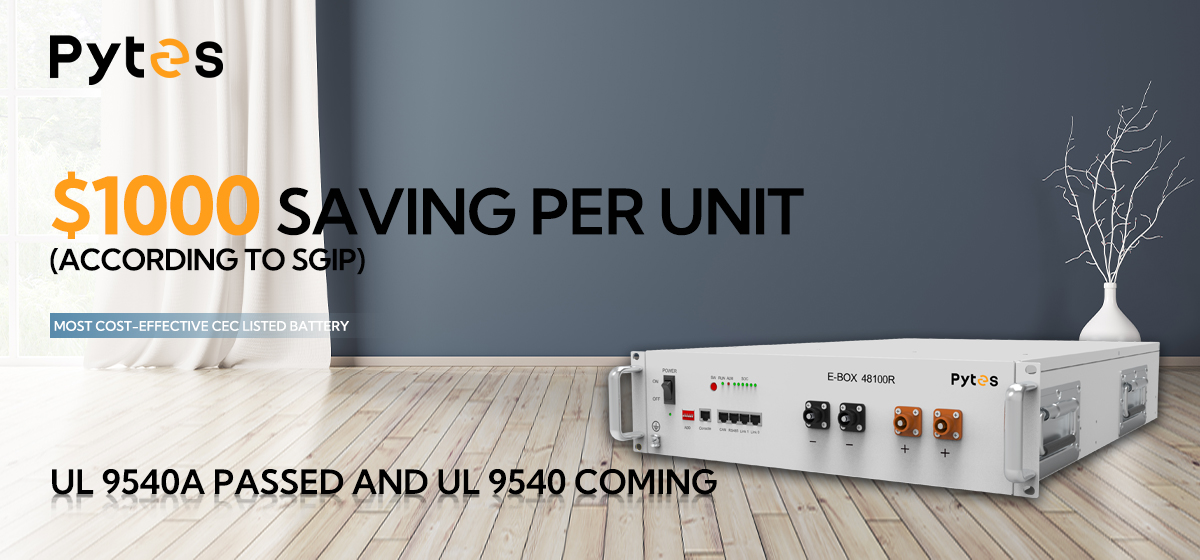$1000 saving according to SGIP
For those who live in California, solar-storage incentive is not an unheard of. The Golden State is home to one of the longest-running storage incentive programs in the country: the Self-Generation Incentive Program (SGIP). Started from 2001, SGIP was approved through Assembly Bill 970 in response to the state’s energy crisis. Since then, the program has undergone many modifications and extensions, helping thousands of homeowners across California to add batteries to their solar systems.

SGIP has three eligibility tiers, general market, equity, and equity resiliency, of which the general market tier is the most common and applicable. Its rebate value declines over time as more batteries get installed in the state and it depends on the size of the battery as well. Currently, there are two remaining levels (Steps 6 and 7) for small-scale residential storage projects. Utilities at Step 6 are offering $200/kWh of rebate funding per battery. For one Pytes 48100R battery, this means $1000 in savings. In Step 7, the rebate will drop to $150 per kWh.
For those who live in a high-fire risk area or other qualifying communities, the rebate values get even higher up to $1,000/kWh, according to the equity tier and equity resiliency tier.
Don’t forget about ITC
With the federal investment tax credit (ITC), storage customers can claim up to 26% of the cost of their solar batteries as credits towards their federal taxes. For whole-home backup homeowners, these credits may save an additional $2,000 to $3,000. The ITC has a stepdown schedule that keeps the credit at 26% through 2022 before stepping down to 22% in 2023.
Thanks to the Inflation Reduction Act, standalone storage will be eligible for this credit starting from 2023. Previously, adding batteries to existing solar system is not eligible for the credit. This soon will get changed and the result will accelerate the installation of energy storage batteries like Pytes 48100R.
CEC Listed
The California Energy Commission (CEC) is the state's primary energy policy and planning agency. It published the latest version of the Building Energy Efficiency Standards in 2022, which encompasses residential and commercial properties. The order requires all newly constructed commercial buildings to have a solar PV array and an ESS installed. According to the CEC, this new mandate will boost an additional 100MW/400MWh of energy storage deployments annually.
Aside from making rules and regulations, CEC also lists equipment that meet its standards. Pytes 48100R has been on a short battery list that references the 2019 Building Energy Efficiency Standard’s Reference Joint Appendix 12 since June, 2022. The list only includes dozens of electrochemical batteries from about 20 manufacturers globally. To get listed the battery system shall be certified to the energy commission to meet a bunch of requirements.
Some of the requirements display CEC’s target on energy safety and efficiency. For instance, the safety requirements dictate that the battery storage system shall be tested in accordance with the applicable requirements given in UL1973 and UL9540. The minimum performance requirements demand an energy capacity retention of 70 percent of nameplate capacity after 4,000 cycles covered by a
warranty, or 70 percent of nameplate capacity under a 10-year warranty.
UL 9540 and UL 9540A
ANSI/CAN/UL 9540 is the North American safety standard for energy storage systems and equipment. Created to address fire safety hazards in the United States and Canada, the standard mainly concerns fire and explosion safety issues, including thermal runaway and fire propagation. The standard actually consists of two earlier, separate standards, UL 1973 for batteries, and UL 1741 for inverters. In addition to those, all UL listed components in a UL9540 ESS shall go through rigorous thermal and electrical testing and evaluation to ensure a safe and high-performance system.
Although UL 9540 is currently not required in most jurisdictions for ESS in the United States, the California building code has adopted International Residential Code (IRC), which requires UL 9540 for ESS. A UL 9540 system not only gives customers peace of mind for safety, but also expedites project permitting and approval with a UL stamp.
With UL 1973 ready and having gone through all the requirements for safety, efficiency and environment, Pytes 48100R battery is on the fast lane to a UL 9540 certification, forming a storage system with Sol-Ark 12K/15K inverters.
Unlike UL 9540, which is basically a certification, UL 9540A is more of a method of evaluating thermal runaway propagation in an ESS. It provides important data for manufacturers seeking to get their ESS products certified to UL 9540 and to verify the effectiveness of the product’s protection against critical hazards like fire. UL 9540A is particularly important for systems with capacity over 20kWh (4 x 48100R batteries), where UL 9540 is no longer applicable. Pytes 48100R battery has well passed all four UL 9540A test stages, which are cell level test, module level test, unit level test and installation level test.
Summary
To sum up, for installers and homeowners in California, SGIP and ITC will certainly reduce most of the upfront cost of any Pytes batteries they might utilize in their residential systems, given that Pytes batteries are the most cost-effective among all CEC listed and UL 9540 certificated batteries. For additional information about Pytes batteries, you can visit the website here.